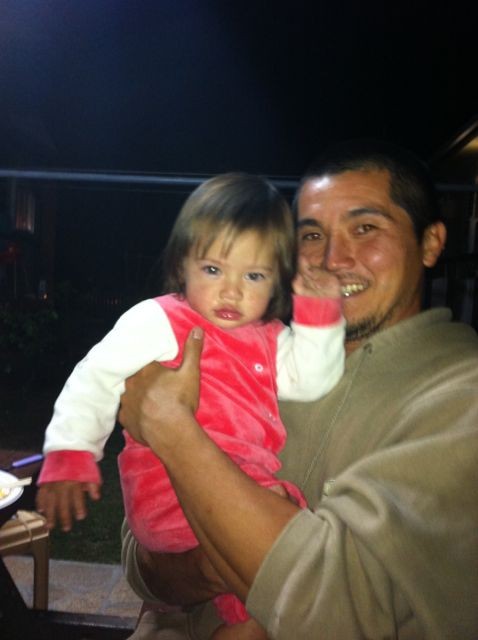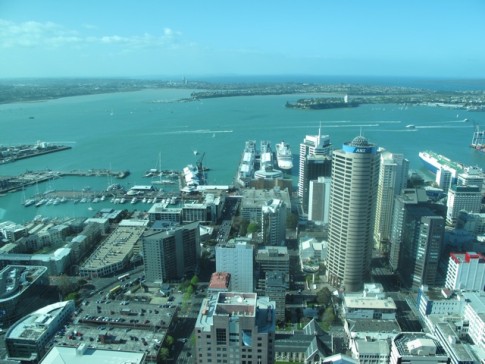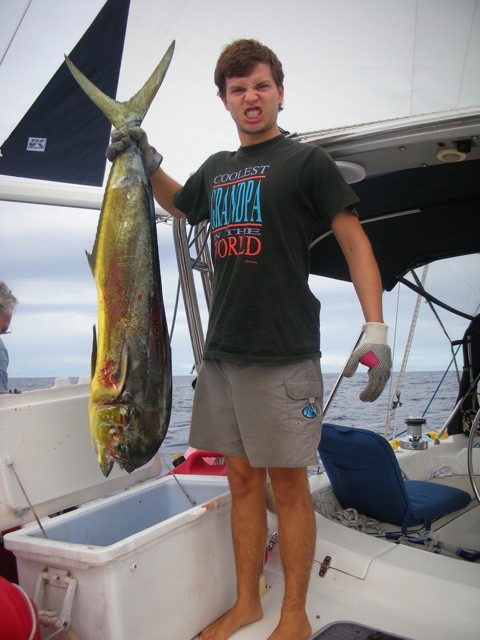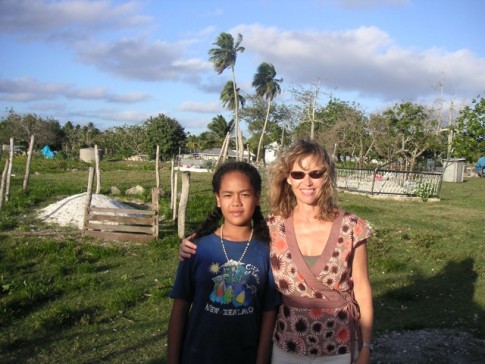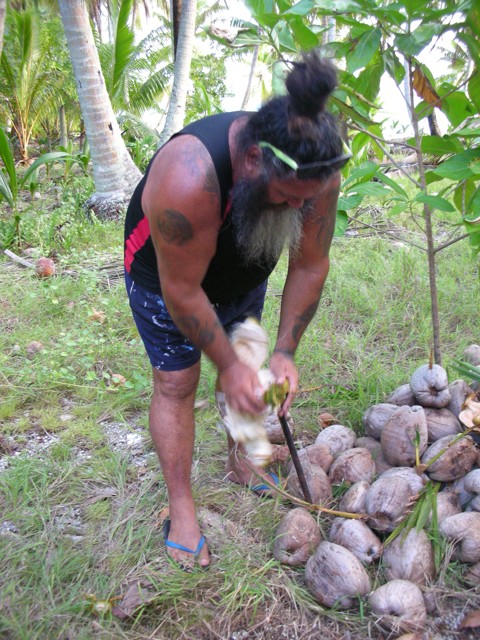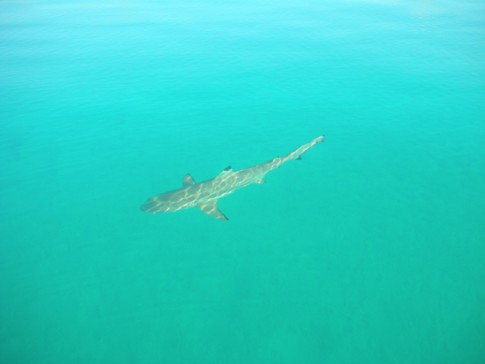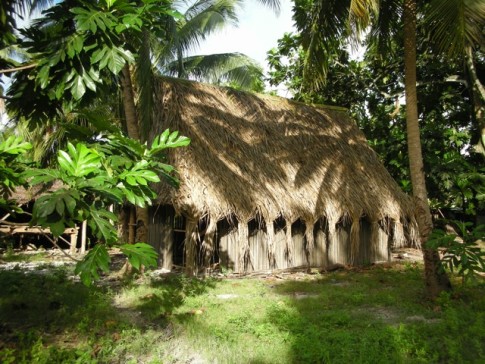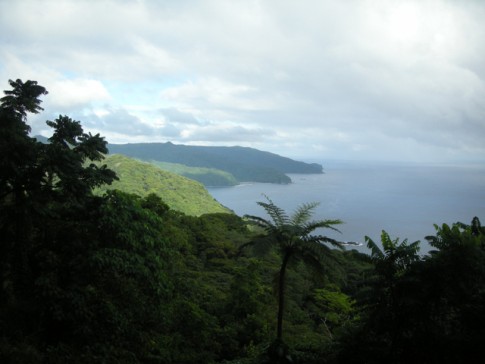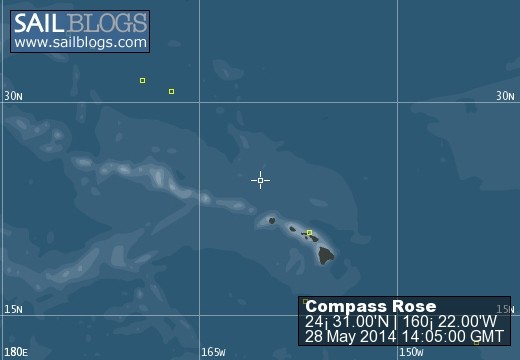
Cruising the South (and North) Pacific
28 May 2014 | ChiChi Jima to Honolulu
24 May 2014 | ChiChi Jima to Honolulu
22 May 2014 | ChiChi Jima to Honolulu
20 May 2014 | ChiChi Jima to Honolulu
19 May 2014 | ChiChi Jima to Honolulu
15 May 2014 | ChiChi Jima to Honolulu
12 May 2014 | The middle of the North Pacific
09 May 2014 | ChiChi Jima
06 May 2014 | ChiChi Jima
04 May 2014 | ChiChi Jima
02 May 2014 | ChiChi Jima
25 April 2014 | ChiChi Jima
07 April 2014 | ChiChi Jima
03 April 2014 | ChiChi Jima
27 March 2014 | ChiChi Jima
21 March 2014 | Chichi Jima, Japan
17 March 2014 | Chichi Jima, Japan
13 February 2014
11 February 2014
06 February 2014 | Dejima/Sakai/Osaka to Honolulu
Sh*t Happens or more hard lessons
17 March 2014 | Chichi Jima, Japan
Captain Rob
Aloha from sunny, windy, beautiful Chichi Jima Japan. I’m finally getting around to blogging about Rob and Ted’s “Excellent Adventure”.
After a month of preparation for our return trip to Hawaii, Ted and I had the boat in pretty good shape. I contacted Commanders’ Weather and they said we should delay our departure for two days. The weather report was awful, but we rationalized that they were just being conservative and there was also the suggestion that if we moved quickly out of Osaka that we could avoid some of the bad weather.
That meant two less days for Ted with his wife Janet in Hawaii, so he was not happy. The thought of sending my new found awesome crew member (who was on a tight schedule) home never occurred to me as an option. So we agreed to wait a couple of days, and on Wednesday, February 5th, we took off. We cleared Osaka Bay and made it to our first offshore waypoint only one hour behind schedule. Things were going fine until day two when the wind started to pick up and Ted got really seasick. By day three we were in a full-fledged Gale. I put out the drogue and we did OK for a day before all hell broke loose and conditions deteriorated even further. Ted was feeling worse but still heroically managed to continue functioning and sharing call.
By this time we were both exhausted, so we decided to put out the sea anchor/parachute and rest until the gale passed. After carefully rigging and organizing all the lines, I tossed out the trip line and float as directed in my brochure. It was immediately caught by the wind and thrown out 100 feet in front of the boat where it promptly got wrapped around the prop and stuck. Needless to say the video they show in the guide takes place in much nicer conditions. I wonder if the Para Tech people ever put out the chute in conditions such as we were experiencing?
One hour later, after cutting the line and repairing the damage, we redeployed the parachute which quickly filled with water. The 400 foot 1’ rode caught my whistle as it flew out, nearly ripping me off of the boat as the line caught on my leg, before the whistle cord broke and I escaped back to the safety of the cockpit. My thought is wouldn’t it have been nice to head the boat up into the wind and waves enough to slow us down before letting the line out? But the 15-foot waves would have been crashing over the side of the boat, so maybe not such a good idea as we were trying to release the para anchor from the safety of the cockpit as directed in the guide. As the main line rushed out it somehow managed to pop the bow bridle off the cleat where it had been carefully tied with 1/4 inch spectra line three days earlier. The large loop that came with the 1” line looked like it was designed for a much larger boat and not my little 10” cleats. Apparently, the thrashing around for the previous three days loosened the line which secured the bridle to the bow cleat. Lesson learned: if the spliced loop in your bridle rode doesn’t fit your cleat, make sure you modify it before using.
The midship bridle adjustment line was cleated too short to get to the winch and despite multiple attempts we were unable to get control, as the waves came crashing over the side. I revved up the main engine and tried to head up into the wind to locate the lost main line but to no avail. I wish I had thought to attach a float to the midship bridle before we released it, but in the excitement of the moment, I didn’t think of that.
I rushed below to get the binoculars and we spent the next half hour trying to motor up to where we thought the trip line floats would be, but they were nowhere in sight. The whitecaps and rushing wind made it extremely difficult to see anything, let alone a small white fender and another small blue fender. Lesson here is you need a nice big yellow or orange float for your trip line.
It was almost dark when we gave up looking for the para anchor and I deployed the drogue with a 200 ft 5/8" 3-ply anchor line.
After several hours with the autopilot in control and moving downwind at 2-3 k, saddened by the loss of the para anchor and its rode, I noticed that the Rose was picking up speed to about 5k. I went aft and pulled on the drogue line to find it was limp . Sure enough, as I pulled in the rode there were areas that had uncoiled and finally a ragged break with no drogue. Now we are para anchor-less and drogue-less and thinking OH SH*T !
On 10 February we were headed SE when we learned about more bad weather ahead and some kind of convergence of fronts south of us. Commanders Weather advised me to turn around and go back to land. After some discussion, we agreed to turn west and head for Okinawa because it would have been too rough to return to Osaka fighting wind, waves and current. The next gale is supposed to be worst on the west side so we wanted to be east of it. The only problem was we didn’t know where it was in relation to us.
On the Pacific Seafarers’ Net on 11 February 2014 Leslie from s/v Carina suggested that Chichi Jima might be a better destination because it’s much closer than Okinawa. After more consideration we altered course and headed for Chichi Jima, about 250 nm away. Soon all hell broke loose and the wind and seas worsened. We were experiencing steady 45 knot winds with gusts to 50 knots and seas building rapidly to 15-20 feet.
We were under bare poles with no drogue or parachute, surfing down monster waves at 11-13 knots. At the peak of the storm, I was steering down this huge wave when the rudder lost control and no matter how hard I tried to turn either way to alter course, the boat wouldn’t turn. We careened straight down the face of the wave.
We nose dived fully expecting to roll head over heels, when the Rose lurched sideways as the bow dug in and we broached to port. The wave crashed over the side, throwing Ted across the cockpit and into the winch, and ripped the Viking life raft right out of its cradle on the starboard stern (among other things that went flying overboard.)
I quickly started the engine and managed to get the bow up into the next wave as it crashed over us. We watched in dismay as the neatly auto-inflated life raft drifted off rapidly downwind towards Saipan.
Thankfully all of this happened in daylight, because the waves were coming from all different directions. Ted would call out where they were coming from, allowing me to adjust our heading so they would roll under us without us losing control. It is unlikely we could have survived this gale in the dark.
Slowly the storm subsided, allowing the auto pilot to take control as we headed SW toward Chichi Jima. Things were settling down when we were hailed on the VHF by Japan Coast Guard 50 A. LuAnne had contacted the Japan Coast Guard in Chichi Jima and told them about our predicament and to expect our arrival. He asked if we could see him. I look about but don’t see any boats nearby.
Then he said "look up." Lo and behold, he is in an airplane out of Tokyo, looking for us.
I let him know we have stabilized and, except for lost equipment and a seasick crew with a sore back where he was thrown into a winch, we are OK. We arrived safely at Chichi Jima the next day, spent hours with Customs, Immigrations and Coast Guard, then fell into our bunks, exhausted. Ted left on the first ferry out of here to Tokyo, where he promptly flew home to landlocked Missouri, probably never to step foot on a sailboat again.
The weeks since then have been consumed with repairing all the damage caused by the storms and awaiting for new parts to arrive. Ah yes, the very definition of cruising -- working on your boat in exotic locations.
After a month of preparation for our return trip to Hawaii, Ted and I had the boat in pretty good shape. I contacted Commanders’ Weather and they said we should delay our departure for two days. The weather report was awful, but we rationalized that they were just being conservative and there was also the suggestion that if we moved quickly out of Osaka that we could avoid some of the bad weather.
That meant two less days for Ted with his wife Janet in Hawaii, so he was not happy. The thought of sending my new found awesome crew member (who was on a tight schedule) home never occurred to me as an option. So we agreed to wait a couple of days, and on Wednesday, February 5th, we took off. We cleared Osaka Bay and made it to our first offshore waypoint only one hour behind schedule. Things were going fine until day two when the wind started to pick up and Ted got really seasick. By day three we were in a full-fledged Gale. I put out the drogue and we did OK for a day before all hell broke loose and conditions deteriorated even further. Ted was feeling worse but still heroically managed to continue functioning and sharing call.
By this time we were both exhausted, so we decided to put out the sea anchor/parachute and rest until the gale passed. After carefully rigging and organizing all the lines, I tossed out the trip line and float as directed in my brochure. It was immediately caught by the wind and thrown out 100 feet in front of the boat where it promptly got wrapped around the prop and stuck. Needless to say the video they show in the guide takes place in much nicer conditions. I wonder if the Para Tech people ever put out the chute in conditions such as we were experiencing?
One hour later, after cutting the line and repairing the damage, we redeployed the parachute which quickly filled with water. The 400 foot 1’ rode caught my whistle as it flew out, nearly ripping me off of the boat as the line caught on my leg, before the whistle cord broke and I escaped back to the safety of the cockpit. My thought is wouldn’t it have been nice to head the boat up into the wind and waves enough to slow us down before letting the line out? But the 15-foot waves would have been crashing over the side of the boat, so maybe not such a good idea as we were trying to release the para anchor from the safety of the cockpit as directed in the guide. As the main line rushed out it somehow managed to pop the bow bridle off the cleat where it had been carefully tied with 1/4 inch spectra line three days earlier. The large loop that came with the 1” line looked like it was designed for a much larger boat and not my little 10” cleats. Apparently, the thrashing around for the previous three days loosened the line which secured the bridle to the bow cleat. Lesson learned: if the spliced loop in your bridle rode doesn’t fit your cleat, make sure you modify it before using.
The midship bridle adjustment line was cleated too short to get to the winch and despite multiple attempts we were unable to get control, as the waves came crashing over the side. I revved up the main engine and tried to head up into the wind to locate the lost main line but to no avail. I wish I had thought to attach a float to the midship bridle before we released it, but in the excitement of the moment, I didn’t think of that.
I rushed below to get the binoculars and we spent the next half hour trying to motor up to where we thought the trip line floats would be, but they were nowhere in sight. The whitecaps and rushing wind made it extremely difficult to see anything, let alone a small white fender and another small blue fender. Lesson here is you need a nice big yellow or orange float for your trip line.
It was almost dark when we gave up looking for the para anchor and I deployed the drogue with a 200 ft 5/8" 3-ply anchor line.
After several hours with the autopilot in control and moving downwind at 2-3 k, saddened by the loss of the para anchor and its rode, I noticed that the Rose was picking up speed to about 5k. I went aft and pulled on the drogue line to find it was limp . Sure enough, as I pulled in the rode there were areas that had uncoiled and finally a ragged break with no drogue. Now we are para anchor-less and drogue-less and thinking OH SH*T !
On 10 February we were headed SE when we learned about more bad weather ahead and some kind of convergence of fronts south of us. Commanders Weather advised me to turn around and go back to land. After some discussion, we agreed to turn west and head for Okinawa because it would have been too rough to return to Osaka fighting wind, waves and current. The next gale is supposed to be worst on the west side so we wanted to be east of it. The only problem was we didn’t know where it was in relation to us.
On the Pacific Seafarers’ Net on 11 February 2014 Leslie from s/v Carina suggested that Chichi Jima might be a better destination because it’s much closer than Okinawa. After more consideration we altered course and headed for Chichi Jima, about 250 nm away. Soon all hell broke loose and the wind and seas worsened. We were experiencing steady 45 knot winds with gusts to 50 knots and seas building rapidly to 15-20 feet.
We were under bare poles with no drogue or parachute, surfing down monster waves at 11-13 knots. At the peak of the storm, I was steering down this huge wave when the rudder lost control and no matter how hard I tried to turn either way to alter course, the boat wouldn’t turn. We careened straight down the face of the wave.
We nose dived fully expecting to roll head over heels, when the Rose lurched sideways as the bow dug in and we broached to port. The wave crashed over the side, throwing Ted across the cockpit and into the winch, and ripped the Viking life raft right out of its cradle on the starboard stern (among other things that went flying overboard.)
I quickly started the engine and managed to get the bow up into the next wave as it crashed over us. We watched in dismay as the neatly auto-inflated life raft drifted off rapidly downwind towards Saipan.
Thankfully all of this happened in daylight, because the waves were coming from all different directions. Ted would call out where they were coming from, allowing me to adjust our heading so they would roll under us without us losing control. It is unlikely we could have survived this gale in the dark.
Slowly the storm subsided, allowing the auto pilot to take control as we headed SW toward Chichi Jima. Things were settling down when we were hailed on the VHF by Japan Coast Guard 50 A. LuAnne had contacted the Japan Coast Guard in Chichi Jima and told them about our predicament and to expect our arrival. He asked if we could see him. I look about but don’t see any boats nearby.
Then he said "look up." Lo and behold, he is in an airplane out of Tokyo, looking for us.
I let him know we have stabilized and, except for lost equipment and a seasick crew with a sore back where he was thrown into a winch, we are OK. We arrived safely at Chichi Jima the next day, spent hours with Customs, Immigrations and Coast Guard, then fell into our bunks, exhausted. Ted left on the first ferry out of here to Tokyo, where he promptly flew home to landlocked Missouri, probably never to step foot on a sailboat again.
The weeks since then have been consumed with repairing all the damage caused by the storms and awaiting for new parts to arrive. Ah yes, the very definition of cruising -- working on your boat in exotic locations.
Comments
| Vessel Name: | Compass Rose |
| Vessel Make/Model: | Hunter 420 Passage |
| Hailing Port: | Lahaina, Hawaii |
| Crew: | Robert & LuAnne Yapp |
| About: | |
| Extra: |
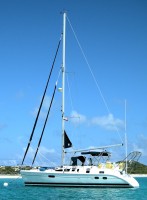
Who: Robert & LuAnne Yapp
Port: Lahaina, Hawaii
